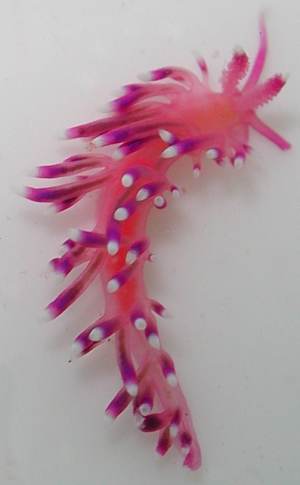
Flabellina arveloi
Ortea & Espinosa, 1998
Order: NUDIBRANCHIA
Suborder: AEOLIDINA
Family: Flabellinidae
DISTRIBUTION
West Africa
PHOTO
Cape Verde Archipelago, October, 2002. Photo: Gonçalo Calado.
Described from West Africa, it appears to be very similar externally to Flabellina marcusorum which was reported in the original description from the east Pacific, Caribbean and Brazil.
• Ortea, J. & Espinosa, J. 1998. Estudio de nueve especies del genero Flabellina Voigt, 1834 (Mollusca, Nudibranchia) colectadas en Angola, Cabo Verde, Costa Rica, Cuba y Portugal, con la descripcion de tres especies nuevas. Avicennia, 8/9: 135-148.
Authorship detailsRudman, W.B., 2002 (December 22) Flabellina arveloi Ortea & Espinosa, 1998. [In] Sea Slug Forum. Australian Museum, Sydney. Available from http://www.seaslugforum.net/find/flabarve
Related messages
Re: Flabellina from Principe, West Africa
December 23, 2002
From: Juan Lucas Cervera.
Dear Bill and Paul,
Concerning Paul's aeolid from West Africa, I would recommend you check carefully the following reference:
• Ortea, J. & Espinosa, J. 1998. Estudio de nueve especies del genero Flabellina Voigt, 1834 (Mollusca, Nudibranchia) colectadas en Angola, Cabo Verde, Costa Rica, Cuba y Portugal, con la descripcion de tres especies nuevas. Avicennia, 8/9: 135-148.
In this paper, Flabellina marcusorum is redescribed from Costa Rica, including a photo. However, in the same paper, a new species of Flabellina, F. arveloi, is described from Cape Verde Archipelago, which resembles (a photo is also included) Paul's animal much more than F. marcusorum. Nevertheless, details of the internal anatomy would help to confirm the ID.
Regards.
Lucas.
lucas.cervera@uca.es
Thanks Lucas,
I have a major problem with papers published in Avicennia as no library in Australia subscribes to it. Fortunately I have just received a message from Gonçalo Calado, with photos of F. arveloi, but I have no information on its anatomy. It is most likely Paul's animal is the same as F. arveloi. I guess what has to be investigated is whether F. arveloi and F. marcusorum are distinct. Ortea & Espinosa, 1998 may present convincing evidence in their Avicennia paper, but I have been unable to obtain a copy.
Best wishes,
Bill Rudman
Flabellina arveloi from Cape Verde Archipelago
December 23, 2002
From: Gonçalo Calado

Dear Bill
Concerning two recently posted messages on the identification of a species of Flabellina, one from Brazil, the other from Príncepe Island (Republic of São Tomé e Príncepe)I would like to share with the Forum some photos of a species, Flabellina arveloi Ortea & Espinosa, 1998 which is very common in Cape Verde Archipelago where I took these photos last October [2002]. I really don´t know if it's a valid species since its external appearence is very similar to Flabellina marcusorum, but at least it is from the Atlantic Ocean. You can also find a good photo taken by Peter Wirtz at http://slugsite.us/bow/wirtz00/cvi_4a.jpg
Regards
Gonçalo
bagoncas@mail.telepac.pt
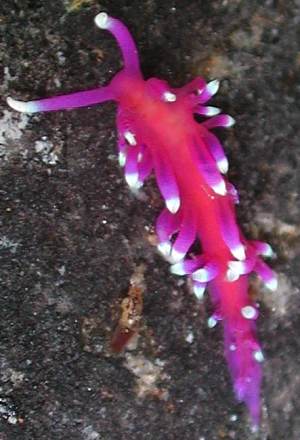

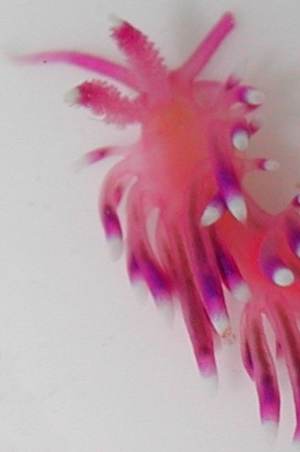
Dear Gonçalo,
Thanks for sharing these photos. As I said in reply to Lucas' message, I have not seen the description of Flabellina arveloi so I don't know if there are anatomical differences between it and Flabellina marcusorum. As you say, externally they do seem to be very similar.
Best wishes,
Bill Rudman
Flabellina from Principe, West Africa
December 19, 2002
From: Paul Young
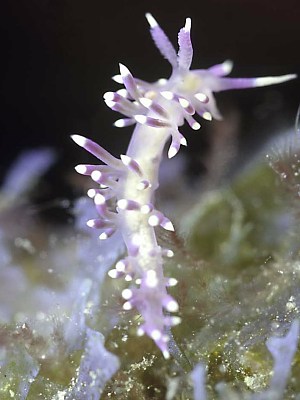
Hi Bill,
We did some diving off Principe (northern island of Sao Tome e Principe, equatorial West Africa), November 2002.
This is the only nudibranch species we found, and is about 15 mm long.
Do you recognize it?
Paul
young@underwater.org
Young, P., 2002 (Dec 19) Flabellina from Principe, West Africa. [Message in] Sea Slug Forum. Australian Museum, Sydney. Available from http://www.seaslugforum.net/find/8696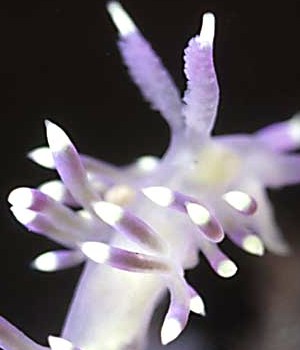
Dear Paul,
I would say that it is a species of Flabellina. I also have a strong suspicion that it is probably Flabellina marcusorum which we recently have had on the Forum from Brazil. Your animal looks very like those in Phanor Montoya's message from the Caribbean coast of Colombia. If it does prove to be this species, then it almost certainly a new record from West Africa. Any comments from those of you familiar with Atlantic species of Flabellina would be very welcome.
Best wishes,
Bill Rudman
